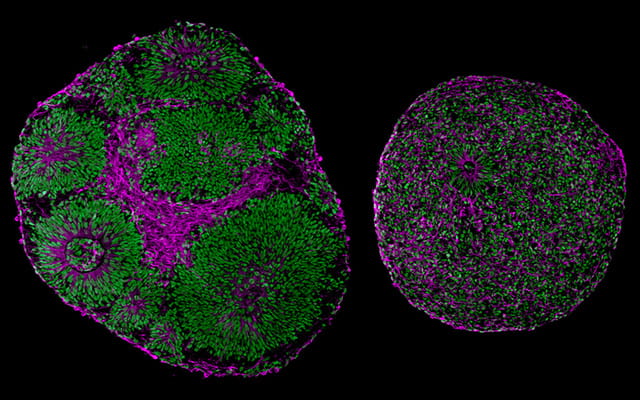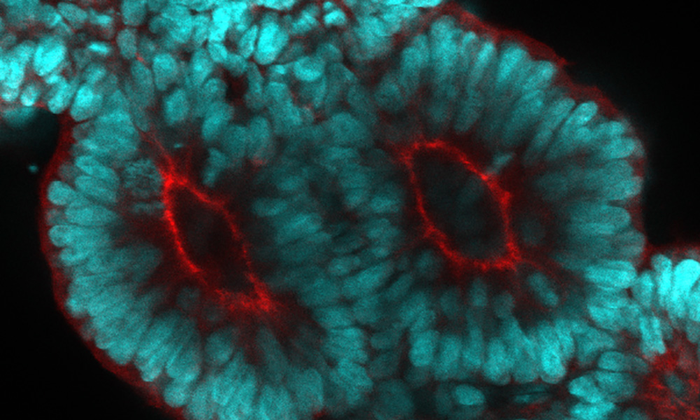The UC San Diego Sanford Stem Cell Institute leads its first space launch, sending stem cells into space aboard the International Space Station. The NASA-partnered study will take advantage of the microgravity environment of space to study accelerated aging in stem cells.
Tag: Molecular Biology
Brain Organoids Reveal in Detail the Harms of Prenatal Alcohol Exposure
UC San Diego researchers used human brain organoids to study the effects of prenatal alcohol exposure on neural development, revealing significant harms in molecular detail.
UT Southwestern scientists among top 1% of highly cited researchers across the globe
More than 20 UT Southwestern Medical Center scientists are among the 2022 Highly Cited Researchers listed in the top 1% of researchers from across the globe
Cedars-Sinai Cancer Leaders Assume New Roles
Lali Medina-Kauwe, PhD, former co-leader of the Cancer Biology Program in Cedars-Sinai Cancer, has assumed a new role as associate director for Basic Research.
UC San Diego Joins NIH ‘Bridge to Artificial Intelligence’ Program
UC San Diego scientists will lead several components of Bridge2AI, a new NIH-funded program to promote the use of AI in health and research.
Call for Papers – The International Halal Science and Technology Conference 2022 (IHSATEC): 15th Halal Science Industry and Business (HAISB)
The Halal Science Center, Chulalongkorn University, and Research Synergy Foundation, invites all to attend “The International Halal Science and Technology Conference 2022 (IHSATEC): 15th Halal Science Industry and Business (HAISB)” and has opened up a call for papers. The conference sessions will be on December 15-16, 2022 at Chulalongkorn University, Bangkok, Thailand.
Key Mechanisms of Airway Relaxation in Asthma Revealed in New Study
Many therapeutics for asthma and other obstructive lung diseases target the β2-adrenergic receptor (β2AR), a G protein-coupled receptor (GPCR) that rapidly supports airway relaxation when stimulated. Yet, overuse of these agents is associated with adverse health outcomes, including death, which has limited their utility as frontline therapies. Now, a mouse model study published in today’s issue of Molecular Cell, from investigators at University Hospitals (UH) and Case Western Reserve University, identifies a novel strategy to isolate the beneficial effects of β2AR stimulation. This suggests a new therapeutic approach to airway diseases as well as numerous other conditions involving the aberrant function of GPCRs.
Did Gonorrhea Give Us Grandparents?
UC San Diego researchers tracked the evolution of a gene variant that supports cognitive health in older humans, but may have first emerged to protect against bacteria.
10 scientists elected leaders of the ASBMB
Voting members of the scientific society chose a new secretary, re-elected three people to the governing council, and selected new committee members.

National Researcher of the Year 2022 Decodes Drug Resistance in Animals – A Step towards Sustainable Solutions
Chula Veterinary Lecturer and “National Outstanding Researcher 2022” has revealed the genetic code that causes drug resistance in animals that affects human health, animals, and the environment, and suggests comprehensive solutions under the concept “One Health”.
ASBMB honors 14 scientists for scientific and community contributions
Biochemists and molecular biologists will give award lectures at #DiscoverBMB, the society’s annual meeting, in March in Seattle.

DNA evolves at different rates, depending on chromosome structure
The structure of how DNA is stored in archaea makes a significant difference to how quickly it evolves, according to a new study by Indiana University researchers.

Gene Therapy Reverses Effects of Autism-Linked Mutation in Brain Organoids
UC San Diego scientists use lab-grown human brain tissue to identify neural abnormalities in Pitt-Hopkins Syndrome and show gene therapy tools can rescue neural structure and function.

Unravelling the origins of the human spine
The spinal column is the central supporting structure of the skeleton in all vertebrates.
Researchers at UC San Diego Identify the Skin’s Master Regulator
Researchers led by George Sen, PhD, associate professor of dermatology and cellular and molecular medicine at UC San Diego School of Medicine, have identified the master regulator controlling the expression of genes regulating how the epidermis attaches to the underlying…
$6M NIH Grant Launches UC San Diego Consortium to Study Insulin-Producing Cells
UC San Diego School of Medicine researchers will receive $6.4 million in National Institutes of Health grant funding to study how external signals and genetic variations influence the behavior of one cell type in particular: insulin-producing beta cells in the pancreas.
Science Snapshots from Berkeley Lab
An experiment to study gravity at the quantum scale, insights into an antibiotic-building enzyme, and the backstory of an incredible new protein prediction algorithm are featured in this month’s roundup of science highlights.
What Makes Blood Vessels Leaky: New Insights for Sepsis Therapeutics
Lab studies reveal protein HSP27’s role in blood vessel leakage, opening the possibility that therapeutically dialing its activity up or down might stabilize patients with sepsis.
American Society for Biochemistry and Molecular Biology names 2022 award winners
The winners were nominated by colleagues and other leaders in their fields for making significant contributions to biochemistry and molecular biology and the training of emerging scientists.
Brain Organoids Mimic Head Size Changes Associated with Type of Autism
Stem cell models derived from people with specific genomic variation recapitulate aspects of their autism spectrum disorder, providing a valuable model to study the condition and look for therapeutic interventions.
Fungal and Bacterial Biodeterioration of Outdoor Canvas Paintings: The Case of the Cloisters of Quito, Ecuador
The journal Critical Review In Eukaryotic Gene Expression has just published an interesting article entitled: “Fungal And Bacterial Biodeterioration Of Outdoor Canvas Paintings: The Case Of The Cloisters Of Quito, Ecuador.”
New Blood: Lab-Grown Stem Cells Bode Well for Transplants, Aging Research
UC San Diego researchers develop a method to grow hematopoietic stem cells in culture, with clinical implications for bone marrow transplants and aging research.
New research on the brain’s relay processes could guide treatment for certain brain disorders
New research shows cells gather more data than once believed inside the thal-amus, a relay station of sensory and motor abilities in the brain. That could change how medicine treats schizophrenia, epilepsy and other brain disorders.
Journal of Biological Chemistry names new editor-in-chief
Alex Toker, professor of pathology at the Beth Israel Deaconess Medical Center and Harvard Medical School, will begin his term Oct. 1.
International collaboration of scientists rewrite the rulebook of flowering plant genetics
How do you study a group of organisms with over 300,000 species, dispersed across all seven continents, and with up to 50 times as much DNA content as the human genome? This is the question posed to biologists studying the…
Interaction identified between SARS-CoV-2 and unusual RNA structures in human cells
Replication of SARS-CoV-2, the virus responsible for COVID-19, depends on a series of interactions between viral proteins and different cellular partners such as nucleic acids (DNA or RNA). Characterizing these interactions is crucial to elucidate the process of viral replication…
Parkinson’s disease: How lysosomes become a hub for the propagation of the pathology
Over the last few decades, neurodegenerative diseases became one of the top 10 global causes of death. Researchers worldwide are making a strong effort to understand neurodegenerative diseases pathogenesis, which is essential to develop efficient treatments against these incurable diseases.…
Characterized drugs show unexpected effects
Known and yet unexpected: many active substances influence the cholesterol homeostasis and thereby possibly a SARS-CoV-2 infection
Study on chromosomal rearrangements in yeast reveals potential avenue for cancer therapy
Researchers from Osaka University uncover a mechanism by which chromosomal rearrangements occur, with implications for novel cancer therapies
DeepMind and EMBL release the most complete database of predicted 3D structures of human proteins
Partners use AlphaFold, the AI system recognised last year as a solution to the protein structure prediction problem, to release more than 350,000 protein structure predictions including the entire human proteome to the scientific community
Fully booked at the bottom of the sea: There seems no room for new bacteria on sand grains
Bacteria on the sand on the ocean floor do not change between the seasons. Presumably, there is simply no room for change.
SARS-CoV-2 variant B.1.617 gives the immune system a hard time
SARS-CoV-2 still poses major challenges to mankind. The frequent emergence of mutant forms makes the threat posed by the virus difficult to predict. The SARS-CoV-2 variant B.1.617 circulated in India and gave rise to the Delta variant, B.1.617.2, which is…
How does the structure of cytolysins influence their activity?
Although Enterococcus faecalis is usually an innocuous member of the bacterial community in the human gut, it can also cause several infections, including liver disorders. The bacteria produce cytolysins, which are molecules that destroy cells. In a new study, researchers…
Genome editing meets marsupials
Researchers at the RIKEN Center for Biosystems Dynamics Research (BDR) have succeeded in creating the first genetically engineered marsupial. This study, published in the scientific journal Current Biology , will contribute to deciphering the genetic background of unique characteristics observed…
New approach eradicates breast cancer in mice
CHAMPAIGN, Ill. — A new approach to treating breast cancer kills 95-100% of cancer cells in mouse models of human estrogen-receptor-positive breast cancers and their metastases in bone, brain, liver and lungs. The newly developed drug, called ErSO, quickly shrinks…
New discoveries reveal how acute myeloid leukemia walks a fine line between growth and cell death
Researchers revealed new insights into how acute myeloid leukemia (AML) develops and progresses, according to a study published in Molecular Cell on July 20, 2021. They describe a mechanism by which AML cells regulate a cancer-related protein, mutant IDH2, to increase the buildup of blood cancer cells—a distinguishing characteristic of the disease.
No IgA leads to intestinal inflammation in mice
Tokyo, Japan – While researchers have known for years that immunoglobulin A (IgA) is important for gut health, it has remained unclear exactly what role it plays in preventing infection and disease. But now, researchers from Japan have found that…
Coffee doesn’t raise your risk for heart rhythm problems
UCSF Cardiology researchers report no link between coffee consumption and arrhythmia
SARS-CoV-2: Achilles’ heel of viral RNA
Researchers at Goethe University find small molecules as binding partners for genomic RNA of the coronavirus
New discoveries reveal how acute myeloid leukemia walks line between growth and cell death
Researchers revealed new insights into how acute myeloid leukemia (AML) develops and progresses, according to a study published in Molecular Cell on July 20, 2021. They describe a mechanism by which AML cells regulate a cancer-related protein, mutant IDH2, to…
To die or not to die in response to stress, a decision regulated by MK2 protein levels
Living organisms are often exposed to stress stimuli generated either by external or internal factors, and they need to respond accordingly. At a cellular level, stress usually triggers the activation of survival pathways that contribute to the recovery of cell…
RedHill Biopharma announces last patient out for phase 2/3 COVID-19 study of oral Opaganib
Top-line results expected in the coming weeks
A breath of fresh air for emphysema research
Tokyo, Japan – Chronic obstructive pulmonary disease (COPD) causes illness and death worldwide. It is characterized by destruction of the walls of tiny air sacs in the lungs, known as emphysema, and a decline in lung function. Little has been…
CNIO researchers clarify the role of the two isoforms of KRAS, the most common oncogene in humans
These findings suggest that for therapies to be effective, they must be targeted at both gene products
How cells control mitochondria
Errors in the metabolic processes of mitochondria are responsible for a variety of diseases such as Parkinson’s and Alzheimer’s. Scientists needed to find out just how the necessary building blocks are imported into the complex biochemical apparatus of these cell…
Add fatty acid to taste
New technology reveals single cancer cells have different appetites for fatty acids
New Sinai Health research finds common denominator linking all cancers
All cancers fall into just two categories, according to new research from scientists at Sinai Health, in findings that could provide a new strategy for treating the most aggressive and untreatable forms of the disease. In new research out this…
New theory suggests blood immune and clotting components could contribute to psychosis
A scientific review has found evidence that a disruption in blood clotting and the first line immune system could be contributing factors in the development of psychosis. The article, a joint collaborative effort by researchers at RCSI University of Medicine…
SUV39H2: A direct genetic link to autism spectrum disorders
New research from the RIKEN Center for Brain Science (CBS) in Japan shows that a deficit in histone methylation could lead to the development of autism spectrum disorders (ASD). A human variant of the SUV39H2 gene led researchers to examine…
How a butterfly tree becomes a web
Evolution is often portrayed as a tree, with new species branching off from existing lineages, never again to meet. The truth however is often much messier. In the case of adaptive radiation, in which species diversify rapidly to fill different…